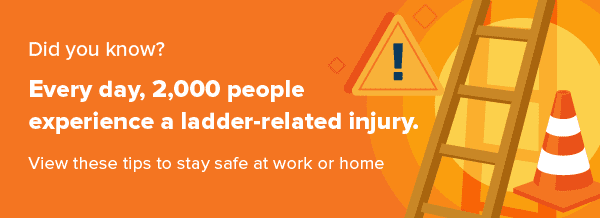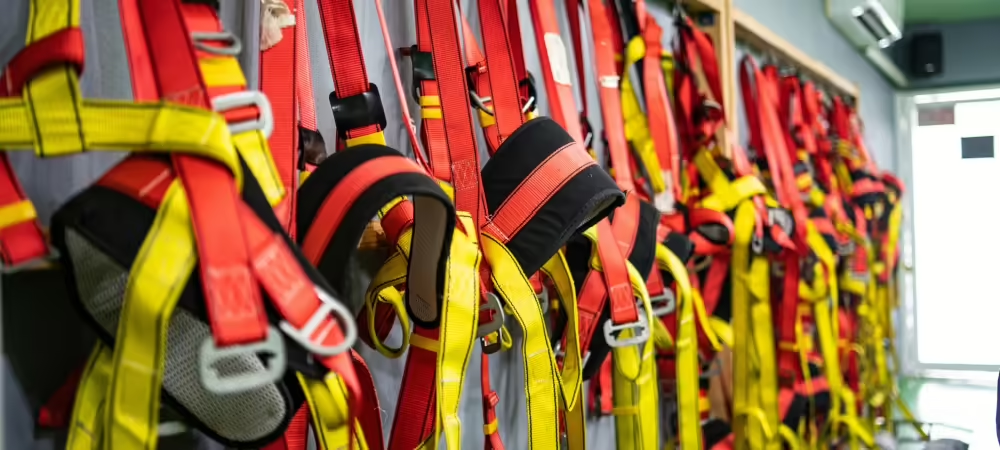
Workers’ Comp Fall Protection: Ladder Safety Basics
Last modified on June 18th, 2021
Ladder Safety Basics: Fall Protection at Work and Home
In today’s fast-paced workplaces, ladder safety and fall protection isn’t always top of mind. In fact, many people are surprised to learn that ladders are a leading cause of injuries both at work and at home. According to research from the American National Standards Institute (ANSI), there are over 130,000 emergency room-treated injuries and more than 300 deaths related to ladder use in the U.S. each year — on average, 2,000 people experience a ladder-related injury every day.

For employers, fall protection plays a key role in preventing occupational injuries and keeping employees safe no matter where they work. Of course, certain industries and worksites are at more risk than others, which is why organizations should develop workplace safety programs that are tailored to the specific hazards their workers face. This proactive approach can help educate employees about proper ladder safety in a variety of environments, ensuring they can confidently use this vital equipment in the office and at home.
Understanding Different Types of Ladders
Ladders come in all shapes and sizes, which can make it challenging to develop workplace safety policies that apply to all situations. The issue is that each type of ladder has different safety concerns and storage requirements. For example, short step ladders do not add much to an individual’s height, meaning any falls would likely be less serious compared to those from higher elevations. To ensure employees are prepared for these differences, organizations should provide background information on a wide range of common ladder types, including:
- Step ladders: These self-supporting ladders are considered the most popular variety, as they can be used in almost any situation. They are portable, easy to store and are typically shorter than 4 feet in height.
- Extension ladders: Extension ladders are often much taller than fixed alternatives and can be adjusted to the appropriate length. However, these types of ladders are not self-supporting, meaning workers will need to lean them against a solid surface.
- Multi-purpose ladders: Multi-purpose ladders combine the features of step and extension ladders into a single package. They can be self-supporting, leaned against something stable or used as a scaffolding in certain scenarios.
- Step stools: These one- or two-step ladders only provide a few extra feet of height, but can be incredibly useful around the home or office. Although falls from these low elevations are often minor, they can still lead to time away from work and costly workers’ comp claims.
Alongside different types of ladders, employers should also educate workers about how the materials they’re made from can impact performance. According to the American Ladder Institute, equipment made from aluminum tends to be more lightweight and portable, whereas steel ladders offer more stability and weight capacity. Whether employees are stringing up holiday lights at home or reaching for a folder on a high shelf, choosing the right tool for the job is crucial to ladder safety.
Portable Ladder Safety Tips
Falls from portable ladders – step, extension, multi-purpose, etc. – are a leading cause of work-related injuries, which is why ladder safety tips should be provided to employees as part of their new hire orientation. In most cases, organizations include this information in their written workplace safety programs, but taking a more hands-on approach can make a world of difference.
FFVA Mutual offers a variety of in-person and online training courses at no cost to our policyholders, including resources dedicated to ladder safety. In terms of workers’ comp, falls from ladders can increase medical, legal and claims costs unexpectedly, and may leave top performers unable to complete their work. As with most safety topics, reducing ladder-related injuries is all about prevention. The more workers understand about ladder safety, the better prepared they’ll be when it’s time to start climbing.
Here are some essential ladder safety tips everyone should keep in mind:
Always Perform a Pre-Climb Ladder Inspection
Even the hardiest ladders will experience maintenance issues eventually, which is why employees should perform a thorough pre-climb inspection. This quick equipment check can help locate issues that may lead to a sudden fall, including loose steps, faulty locking mechanisms, warped rails and more. Alongside the ladder itself, workers should also survey the area to ensure they’re on stable ground before climbing. Ladders should always be set up on a firm, level surface as close to ground level as possible. View this short 3-minute ladder inspection video for five areas to look for when inspecting a ladder and what to do with defective ladders.
Follow the 3-Point Rule
One of the most important ladder safety practices is the 3-point rule: Individuals should always maintain at least three points of contact when climbing a ladder to avoid losing their balance. For example, keeping two feet and one hand on the ladder can help employees stabilize themselves as they climb, reducing the risk of a fall. The Occupational Health and Safety Administration (OSHA) also recommends keeping your body near the middle of the step and always facing the ladder when climbing.
Use a Spotter
Even minor repair and decoration projects can go wrong unexpectedly, which is why everyone should have a spotter on site when climbing a ladder. This buddy system can help keep the ladder stable should someone lose their balance, or if the equipment has a major malfunction. When using a ladder in a crowded or high-traffic area, it’s also useful to set up a barrier to prevent people from walking too close to the work being performed.
Pay Attention to the Ladder’s Weight Capacity
Every type of ladder comes with its own maximum weight capacity. Exceeding this limit can cause the ladder to buckle or experience another dangerous malfunction, which puts the climber at risk. If an employee needs to perform some kind of task while on a ladder, it’s crucial to check the manufacturer’s directions to understand its load rating. Workers must also consider the weight of tools, equipment and replacement parts before climbing to ensure they’re within the acceptable limits.
At FFVA Mutual, we believe employee health and safety extends far beyond physical workplaces. Our team of safety consultants is constantly developing new training and support materials aimed at reducing injuries, illnesses and deaths, whether they occur at the office or at home.
To learn more about our ladder safety and fall protection, click here to view our Ladder Safety Trending Topic sheet with related resource links, explore our training request form or contact a Solutionist today.
FROM OUR BLOG
SEE MORE POSTS
Fall Protection: 5 Steps to Stay Compliant

Creating a Safer Workplace with Total Worker Health
